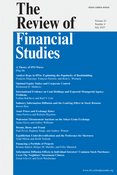-
Views
-
Cite
Cite
Todd Mitton, Keith Vorkink, Equilibrium Underdiversification and the Preference for Skewness, The Review of Financial Studies, Volume 20, Issue 4, July 2007, Pages 1255–1288, https://doi.org/10.1093/revfin/hhm011
Close - Share Icon Share
Abstract
We develop a one-period model of investor asset holdings where investors have heterogeneous preference for skewness. Introducing heterogeneous preference for skewness allows the model's investors, in equilibrium, to underdiversify. We find support for our model's three key implications using a dataset of 60,000 individual investor accounts. First, we document that the portfolio returns of underdiversified investors are substantially more positively skewed than those of diversified investors. Second, we show that the apparent mean-variance inefficiency of underdiversified investors can be largely explained by the fact that investors sacrifice mean-variance efficiency for higher skewness exposure. Furthermore, we show that idiosyncratic skewness, and not just coskewness, can impact equilibrium prices. Third, the underdiversification of investors does not appear to be coincidentally related to skewness. Stocks most often selected by underdiversified investors have substantially higher average skewness—especially idiosyncratic skewness—than stocks most often selected by diversified investors.




